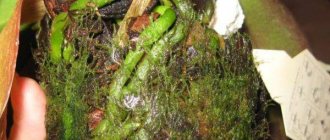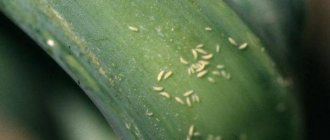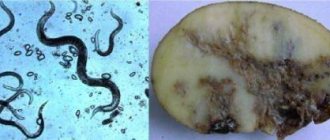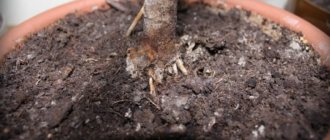Earthworms benefit the soil of garden plants, but what about indoor plants? Let's consider all the PROS and CONS.
Not all worms are the same. Just because you find them in a garden, yard, or in a potted plant doesn't make them an earthworm, even if they look similar. Regardless of the type of worm, their waste is a benefit to the soil and plants. However, earthworms in pots can damage the root system, especially of young plants.
The common earthworm has completely different habits than the worms used for composting. The common earthworm, known as an earthworm, digs deep burrows and comes to the surface of the soil at night to find food. Earthworms regularly return to the same burrows and can burrow up to 2 meters deep.
Composting red worms, although they look much the same, do not burrow deeply; they eat decaying material near the surface, turning it into humus, which provides beneficial nutrients to the soil. Although some people may think of them as earthworms, they are a little different. If you put them in a tank, they will stay near the surface, in the top
compost, at
the top
of the bin, rather than in a deep hole somewhere below, like their relatives, earthworms.
Tell me, if there are worms in indoor flowers or pots, is this good or bad?
clinical blonde
Over time, they will begin to eat the roots of your flowers. . Get rid of it. It is necessary not only to change the soil, but also to scald the pots to get rid of the larvae..
s-elena66
This is bad. Replant the flowers.
Alexander Pushkin
If it’s rainy, it’s not dangerous, but if it’s roundworms, pinworms, tapeworms, it’s a big deal!!!
Personal Account Removed
Fine
Puppeteer
Earthworm Earthworm (Lumbricidae)
Length from 2-3 cm with thickness approx. 1 mm to 50 cm with a thickness of 1.5-2 cm. Approx. 300 species, widely distributed; most numerous in forest and forest-steppe zones. They live in the soil, are nocturnal, and crawl to the surface during the day after heavy rains. Soil formers. 11 species are protected. Earthworms (the family of oligochaetes) are usually considered beneficial organisms, but in a small pot of houseplants they can be harmful.
Harmful effects Normally, they feed on plant debris, but in a pot, when there is a shortage of fresh organic matter, they easily switch to living plant roots and underground shoots and rhizomes. Earthworms spoil the soil in flower pots with their liquid sticky secretions, clog the drainage, causing the soil in the pot to turn sour. If there are earthworms in the earthen coma, characteristic lumps of earth appear on the surface, thrown out by them from their passages. If there are earthworms in a pot, the plant becomes lethargic and stunted in growth.
Control methods Soil from the street can contain not only adult individuals, but also eggs. Therefore, it is better to sterilize garden or forest soil in one way or another before use. If plants are taken outside in the summer, place the pots only on pallets and so high that earthworms cannot climb into them. At the same time, worms rarely appear and successfully reproduce in pots with indoor plants due to the peculiarities of preparing soil mixtures and the watering regime. But if they have already appeared in the pot, you need to immerse the pot with the plant in warm water for half an hour - the worms will either crawl to the surface, where they can be easily collected, or drown. It is also quite easy to collect large worms when replanting. You can water the soil in the pot well with a pink solution of potassium permanganate.
Natalya Kalantyr
They gave you a very good answer, I didn’t have time. Indeed, all flowers must be replanted, be sure to wash them with a solution of potassium permanganate. Otherwise they will devour all the roots and the flowers will die. Good luck!
tonyte
bad, change the soil, it’s better to buy it in a store, there definitely won’t be any larvae there.
Lena
don't change anything. just scrape the Mashenka chalk above the ground in the pot, it is designed to fight flies and ants. tested by my own experience, all creatures disappear.
Nifri
if it’s rain, then it’s good, thanks to them the roots breathe, but if there’s maggots or something else, replant...
Im@go
This is bad! And if you have lice in your head, will you also be here to find out whether this is good or not?
Natalia
Earthworms in flower pots are good! They process the soil and fertilize it; some people specially plant them in flowers if it is not possible to replant and you want to renew the soil!
love it
earthworms in a pot are a disaster - this year I experienced the hard way of their eviction, and I always buy land - I don’t save, one of the packages was with... (under the ellipses read the bad words) arrowroot almost disappeared, until I realized that now there is only one small leaf sitting, and in order to remove them I had to completely wash off the soil from the roots, all other methods did not work, the Amazon lily had dying coencentric circles on the leaves, it was not possible to save my favorite rose, I suffered all summer and to this day I am not sure that I managed it everywhere , I soaked myrtle 4 times - it’s big and a complete replacement for the earth, it’s like death for him, and potassium permanganate makes him feel bad, show me that idiot the cat puts them in there on purpose
Galina
And I put an earthworm in each pot. The flowers and I are happy, the worms, I don’t know, but they’re alive.
Irina Kirilova
It’s bad for flowers, but I don’t know for you.
Lyudmila Otradnaya
Any worms (even earthworms) are very dangerous for indoor plants: the plant slows down its growth and then dies. It is urgent to change the soil, wash the roots with running water and a weak solution of potassium permanganate. Before planting, roast the pot in the oven and cool.
How to get rid of worms
Regardless of which pest has settled in home flowers, they all live in the soil. It is hardly possible to simply remove them from the ground. Transplanting into a new soil mixture will help only if the infection occurred recently and the colony has not had time to grow. It's done like this. The roots removed from the soil are carefully examined. All infected or damaged areas are removed and the sections are disinfected.
All adult parasites are removed or washed off from the root shoots. Larvae and eggs cannot be removed this way. Therefore, immediately after transplantation, the soil mixture is treated with an insecticide solution. It must be understood that this technique will be effective only if the number of insects is small. In other cases, chemicals or folk remedies will help. It's better to start with non-toxic methods. If they don't help, move on to stronger remedies. We offer effective ways to get rid of worms in flower pots.
Insecticides
For control, different types of insecticidal preparations are used. We offer a list of the most effective ones.
Insecticides
"Inta-vir". Nerve poison. Causes the death of parasites within 24 hours. The eggs remain intact. "Carbation". Sterilizes the soil, protects flowers during budding and flowering. Can be used once. Fumigator type drug. "Confidor". Penetrates into plant tissues and remains in them for a long time. Worms are insensitive to it and only kills insects. "Fitoverm". Paralyzes the nervous system of worms and insects. Twice application is recommended. "Agravertine". Effective against all types of parasites, non-toxic to humans. In hot weather its effect is enhanced.
Before getting rid of worms using insecticides, you must carefully read the manufacturer's instructions. The drugs are toxic, so it is necessary to strictly follow the dosage and safety rules. Otherwise you may get poisoned.
Folk remedies
These drugs are non-toxic and not dangerous to people or pets. But their effectiveness is lower than that of insecticides. Perhaps they will not help in the fight against a large colony, but at the initial stage or as a prophylactic agent they are quite effective. We offer a list of methods on how to get rid of white worms in flowers.
Non-toxic techniques
Prepare a water solution of soap. It is best to take household goods, made according to GOST, with a high fat content. Soap shavings are diluted with water, and the resulting solution is sprayed on the infected bush. The treatment is repeated several times. Dissolve 5 g of tobacco leaves ground into dust in a liter of clean water. Allow the drug to brew for 24 hours. Spray the infected bush and the soil in the pot generously. Treat the bush in this way every 6-7 days for a month and a half. Dissolve potassium permanganate crystals in water to obtain a pale pink liquid. Water the flower bush with it. Repeat the treatment several times. Place garlic cloves or citrus peels on the ground inside the pot. You can treat the soil with a strong-smelling oil, such as anise or rosemary.
Some flower growers are confident that sulfur from matches will help get rid of parasites. It is scraped off and the powder is sprinkled on the soil, or matches are simply stuck near the stem with the heads down.
Country cottage area
How to get rid of whiteflies on home flowers and seedlings
There are earthworms in the pots of indoor flowers, what should I do? Is this harmful or good for the flowers?
Klava Ivanova
an earthworm in a flower pot is a disaster, this year I received this gift with purchased soil - in the bulbous ones I first discovered that strange spots appeared on the leaves, they curl up at the bottom and chew and chew..., I had to replant them a second time, but not all the plants you can completely clear the old soil without loss... in some varietal fuchsias I discovered it too late and even the cuttings could not be rooted; a solution of manganese and immersion in water up to my ears also does not always work.... I sympathize - take action, I advise you to start rooting delicate plants again = while there is somewhere to take cuttings from
stasya
what passions you tell! the soil was visible from the garden... from the dacha... buy ordinary soil for indoor flowers and replant!
Ildar Iskandarov
Healthy
miha1968
useful, loosens the soil
Yuri Vasilievich.
very helpful
Andrey Neizvestny
They won’t grow on their own, apparently they were in the ground. There is nothing terrible, throw away the dead ones (or fry them). Flowers will only say thank you.
Vasilich
Just say so: my little man is a famous fisherman...
Anastasia K********
I would like to know if you have meter-long flower pots or if you have children who make fun of you????
Natalia Sidorova
My earthworms ended up chewing off the roots of the bulbous flowers and they all died, so it’s best to change the soil. Worms are good in the garden, they loosen the soil there, but at home they are parasites!
Anastasia Mazanko
Worms do not appear on their own in indoor pots; ask your husband if it was his doing.
Anna Vasyukova
My flowers died after the worms appeared; after all, they feed on the roots.
(=sm!Le=)
biting! get mirror carp. You will have phosphorus in almost unlimited quantities. Feed the worms with squeezed tea leaves. Forget about flowers - they don't bring happiness...
GIT+A
that’s the thing: if there are a lot of them, they are harmful!!! and they came from purchased soil, but this is not the only gift that can be bought along with the soil
Lyoshka the stove maker
Dilute potassium permanganate until pink and water the flowers. If once doesn't help, repeat. Only pink solution! Don't burn the roots.
maria_johansson
While there are few worms and the pot is large, they eat old leaves and roots, just like in nature. Once there are a lot of worms and a small pot, the worms eat everything they come across. I got into a lot of trouble last winter when flower pots from the garden were brought into the house, and in the garden worms entered the pots through a hole at the bottom and took root. This summer, I lined the bottom of the pots to keep out worms and ants with cloth or plastic mesh, then with stones to drain water, then with soil. There were no worms in such pots, and in 2 pots I did not close the loophole and now I had to urgently save 2 flowers (calla lilies), the roots were all eaten by worms. Of course, in the garden they have a lot of food and they don’t attack my plants that much, but at home in flower pots they are big pests.
Andrey Zhurba
They feed on dead roots!! ! Perhaps you are shifting Your blame onto the worms? “Worms excellently prepare the soil for plant growth... They sift the soil so much that no dense mineral particles remain in it... They thoroughly mix all the soil, like a gardener preparing crushed soil for his most exquisite plants” (C. Darwin). While soil microorganisms and plants fix soil chemical elements in their cells, earthworms and other soil invertebrates help remove these elements from plant organic matter and microbial biomass, thus providing food for new plants. In this cycle of substances, earthworms, these little tireless workers, act as regulators of the activity of microorganisms, enriching the soil with natural nitrogen, phosphorus and potassium, balanced among themselves. Also especially valuable is the fact that worms absorb and digest not only humus, but also bacteria, algae, fungi with their spores, protozoa of the animal world (including nematodes!) - these are real deodorizers and orderlies, soil improvers, disinfecting pathogenic soil microflora.
Earthworms pass a large mass of dead plant matter through their intestines, in which the plant tissues are finally destroyed, digested and then mixed with the soil. Thanks to the activity of earthworms, the compost “matures” faster, turning after their processing into a loose, loose, consisting almost exclusively of granular excrement of worms, an environmentally friendly and extremely useful fertilizer (vermicompost), which is easily absorbed by plants. It is also especially important that plant residues processed by earthworms acquire unique and valuable properties for the soil, since they are transformed into water-resistant, water-intensive, fertile structures.
ALEX
I also asked this question, look at my answers; This is how my cheflera died; I wasted away for no reason, no matter what I did; then I noticed that the earth was being sifted into the pan, I dug up a flower - there were so many worms that they were literally swarming; didn’t save the flower; I think they got started with the purchased soil
Lelya
I had them too. Nasty!! ! I felt so disgusted that I threw it away along with the flower. And I washed the pot with “Whiteness” soap.
There are earthworms in a flower pot. Is this harmful to the flowers?
Klava Ivanova
God, how many people like to give untried advice, worms in a pot are not to the taste of any plant - it’s just a disaster.. “...they loosen the earth, but there is no mouth. “..I didn’t look for the worm’s mouth, but when I took the eucharis out of the pot, the bottom of each bulb was eaten away and decorated, it lay there in a ball, like a worm..., and I lost half my collection of fuchsias - the bitten plants die and the cuttings from them are useless they don’t take root... in general, take out the tuber and carefully collect this crap...
Kundyz Akhmetbekova
I think not, they seem to be loosening
Apricotik
this is useful! The plant's roots will receive more oxygen.
S.U.
No! they are loosening the earth!
Free
Basically good... Just add tea leaves (used tea leaves)
Ba®n
Cool! give the soil recipe (must be reported to the Red Book)
Eduard Mirgayazov
but useful for worms
UndergroundLady
The long-term presence of earthworms in the soil spoils and oxidizes it
Valentina Smirnova
It's not harmful to plants, but why do you need it? Replant and that's it.
Julia
The pot is too small for worms - in nature they have more land, but they eat! They will loosen them, of course, but they will also eat the roots of the flower! ! Therefore, remove either the flower or the worms
Sonya Khusaenova
You need to remove them, the flower will come to life.
✿Elena m✿
You need to remove them immediately, they multiply quickly and begin to feed on the roots of the plant.
Online store for you
Worms have no teeth and cannot bite off living roots. But they will eat rotten roots and secrete a bunch of all sorts of goodies for plants (the ENTIRE fertile layer of the earth is developed by worms.) If there is only one worm in the ground, it will not reproduce, but if there are two, then there will be offspring (they are hermaphrodites). Not all worms reproduce quickly, but only some types (California, Vladimir prospector...) Do you have purchased land or from a garden? If purchased, then there may be the first two types - they are sometimes used to produce this very land. And if it’s from the garden, it’s most likely a slowly reproducing worm...
Lydia
on the one hand, it’s good that they loosen the ground and the air passes to the roots, but on the other hand, the flower is not very comfortable, I had this and each flower needs its own care.
Irina Ermakova
Worms are good in open ground, in compost heaps, in harvested soil (say, layers of turf). Earthworms feed on organic waste; if you do not plan to start a compost heap in a pot, then the worms will begin to eat the roots of the plant. Perhaps your gloxinia has begun to wilt due to damage to the root system by worms, completely immerse the pot in a bowl of water, the worms will crawl to the surface, so they can be removed from the soil. In the summer, if you take the plants outside, the opening of the pot should be protected from pests getting into it. Sift or steam the soil before planting.
Lyubov Ovsyannikova
harmful, replant the plants
Irina Kalugina
Worms are not very good in pots, they harm the plant, they are only useful in open ground
Oleg
I had the same thing with figs. I read different opinions on this matter on the Internet. Many people wrote that this was good. Others - which is bad. Like you, I didn’t understand why figs weren’t growing well. Still, I decided to get rid of the worms. I read on the Internet one good way. I immersed (sank with the top) the pot in water with a temperature of 50 degrees (in the bathroom) for half an hour. The plant can withstand this temperature, but the worms cannot. After this, the figs began to grow well and this year (already last year) produced 5 delicious fruits.
Svetlana
I removed 3 Kalanchoe flowers from worms. They are useful in the garden in summer, and indoors in winter. harmful to plants: The long-term presence of earthworms in the soil spoils and oxidizes it. In this case, it is best to transplant the plants into new soil, but if the soil is not yet spoiled, then the worms must be removed, because when they drill their passages in the ground, they expose some of the roots and thereby cause some harm, especially to more tender plants. However, it is not difficult to get rid of earthworms: you just need to water the plants once or twice with hot water, 45-50 degrees, but not with boiling water; Such watering causes the worms to crawl to the surface of the earth, where they are easy to collect.
House in flowers. How to get rid of earthworms that have settled in the soil of a pot?
03/15/2016 13:03 | | Crop production
Earthworms in the soil of a flower pot are the most unpleasant thing that can happen in home gardening. I think it’s no secret to anyone that earthworms in the soil of a flower pot are parasites. It is quite difficult to recognize trouble in the early stages of soil contamination. Usually the presence of worms becomes noticeable when they have already bred. At the same time, you can find burrows on the surface of the soil, and nearby there are piles of processed earth, particles of which will be washed into the pan. And the most accurate determination of the presence of worms in the soil of indoor plants is visual. If you look closely, you will see how, after watering the plant, the worms crawl to the surface.
Worms in a flower pot, what to do?
Elena*
Earthworms are bad. As long as there are nutrients in the ground, they are not dangerous, but as soon as everything is over (when everything ends), they are taken up by the roots, especially young roots. When earthworms started appearing in the pot, I tried everything, actara and potassium permanganate, and washed the roots. Everything is useless. It got to the point that I even left it with the washed roots in a bucket of water overnight. I thought they would choke. But no. When I lifted the plant (it was crescent asparagus) from the water, I saw a terrible picture. The worms hung like ropes attached to the roots. I removed them with tweezers. The drug CONFIDOR helped me. I spilled the soil twice with an interval of 1-2 weeks. Earthworms breed very quickly in a favorable environment.
Murmur
There is a drug called AKTARA. diluted in water. buy it at the store and use it to water pots of plants.
Alexander
fishing with a pot
Valentina Dylgina
If it's raining, that's fine.
Emilia Bilyauer
dilute a weak solution of potassium permanganate and pour it in
Vladimir Emelianenko
Throw it away quickly, it's a nightmare and unsanitary!!
compas
Digging and fishing... all year round, worms are useful for plants - they loosen the soil.
olga
The soil will have to be thrown away, the roots of the plant should be washed in a light solution of laundry soap. Rinse the pot and pour boiling water over it. Heat the new soil in the oven before use...
Irina*
I think that it is best to change the soil, even if it is purchased, you never know what kind of worms they are, what if you don’t get them out? Wash the pot, change the soil and let your palm tree rejoice.
Lydia
I had the same problem - three cacti were eaten (((they also recommended potassium permanganate to me... watered it, the fourth cactus still seems to be alive. Only the solution should be very weak
Vera Shelest
A slug crawled out of my purchased soil in a sealed bag. Lively, it immediately crawled to eat the leaves. This is the kind of land we pay money for! I now began to steam the soil on the stove in a saucepan. I advise you to remove the flower from the pot and steam the soil.
Katya Kotovich
these are most likely trimatodes (small, white), they are not so easy to get rid of, potassium permanganate will not help here, you need to completely clear the roots of the tree from the soil and wash the pot, otherwise the tree will die, these creatures live in the ground, they came to you that way, the seller did not checks the ground, eats everything, from plant roots and snails to the ground. so hurry up!
Alinka Malinka
Immerse the pot in a bucket of water for half an hour. . maybe so? Don't know.
Lady with a dog
I had the same story, worms are harmful, they feed on the most delicate small roots, pour very warm water (40-50 degrees) into a container and place a pot with a flower in it for 5-10 minutes so that the water level does not reach the top of the pot 2 cm after the worms will crawl out to the top You collect them for fishing, as advised above :0))) the only negative is that the ground gets wet through and through in cold weather, this absolutely cannot be done
Catherine
I also had rain ones. It's OK!
Marina Mirutenko
Earthworms are completely harmless! And they don’t eat any kaorns, they consume earthly organic matter and, passing through themselves, structure the earth. But they described how to bring others out.
Natalie Filini
Earthworm (Lumbricidae)
Length from 2-3 cm with thickness approx. 1 mm to 50 cm with a thickness of 1.5-2 cm. Approx. 300 species, widely distributed; most numerous in forest and forest-steppe zones. They live in the soil, are nocturnal, and crawl to the surface during the day after heavy rains. Soil formers. 11 species are protected. Earthworms (the family of oligochaetes) are usually considered beneficial organisms, but in a small pot of houseplants they can be harmful.
Harmful effects Normally, they feed on plant debris, but in a pot, when there is a shortage of fresh organic matter, they easily switch to living plant roots and underground shoots and rhizomes. Earthworms spoil the soil in flower pots with their liquid sticky secretions, clog the drainage, causing the soil in the pot to turn sour. If there are earthworms in the earthen coma, characteristic lumps of earth appear on the surface, thrown out by them from their passages. If there are earthworms in a pot, the plant becomes lethargic and stunted in growth.
Control methods Soil from the street can contain not only adult individuals, but also eggs. Therefore, it is better to sterilize garden or forest soil in one way or another before use. If plants are taken outside in the summer, place the pots only on pallets and so high that earthworms cannot climb into them. At the same time, worms rarely appear and successfully reproduce in pots with indoor plants due to the peculiarities of preparing soil mixtures and the watering regime. But if they have already appeared in the pot, you need to immerse the pot with the plant in warm water for half an hour - the worms will either crawl to the surface, where they can be easily collected, or drown. It is also quite easy to collect large worms when replanting. You can water the soil in the pot well with a pink solution of potassium permanganate.
Elena
you can decide here which worms are in your pot
[link blocked by decision of the project administration]
samuel etoo
from 1cm-4cm pale pink color
If there are earthworms in the soil of indoor flowers, they can be removed without replanting the flower.
Karpik
So that's it. DON'T LISTEN TO THE BULLSHIT. WE NEED TO BRING THEM OUT!! ! everything is connected with their nutrition, they not only loosen the soil, they feed on organic matter, when the rotting is over, they will start eating the flower...
Tatyana Yakimova
You can’t, you need to shake out all the soil.
Peganov Yuri™
There is no need to take them out - it’s even useful - they loosen the ground!!!
EARTHWORM :
The family of earthworms (Lumbricidae) consists of almost 170 species, and belong to the phylum Annelides. All earthworms are similar in their lifestyle. They live in damp places, swarming tunnels underground, and in cold and drought they go deep into the ground. After heavy rains, due to lack of air, earthworms are forced to rise to the surface. They feed on decaying plant debris and soil microorganisms.
The extremely positive role that earthworms (aka Lumbricus terrestris) have played (and continue to play) in the processes of creating fertile and living soil is widely known. We can talk about this endlessly, but this is a separate conversation. In a nutshell, an earthworm is a continuously operating mini-factory for the production of humus (soil organic matter).
Among some flower gardeners, there is a widespread belief about the harm that earthworms can cause. Which (allegedly) gnaw roots in pots, gnaw at young shoots, eat seedlings, sprouts, seeds, etc. To destroy worms, they come up with different methods, the most harmless of which is freezing the soil. And what’s most offensive is that they say (especially on the Internet) all sorts of unfounded nasty and stupid things about earthworms...
The peculiarities of digestion make earthworms detritivorous, i.e. They feed on detritus - decaying plant organic matter (in combination with soil particles) located on the surface of the soil or in their underground burrows, as well as in the soil itself. Therefore, the coprolites that the earthworm leaves behind are lumps of soil enriched with nitrogen, microelements, and having low acidity due to the alkaline environment of its intestines. Because of its slowness and thoughtfulness, the earthworm does not have time (and is even embarrassed by prying eyes) to eat detritus, and therefore drags it into storage deep into the soil, saturating it with organic matter and feeding its smaller brothers. In addition, thanks to the numerous passages and burrows of earthworms, the air supply to the soil and all its inhabitants and plant roots is significantly increased.
What practical conclusions can be drawn from the above reasoning?
1. There is no need to be afraid of worms, expecting any harm from them. They cannot cause it because of the peculiarities of their diet (Nature acted very wisely...). Although they do have teeth! As for their life in pots (with indoor plants or seedlings), there is only one extreme case that it is advisable to avoid: when the volume of the pot is so small compared to the size of the worm that it turns it (the worm) into Ivan Matveich living in a crocodile... :-))
2. Knowing the digestive characteristics of a worm, you need to create appropriate conditions for it in the garden for life, rest and reproduction. And then all problems with the quality (structure, fertility, etc.) of the soil in the garden will be solved by themselves. More precisely, earthworms will do everything for you. I can say that in my garden, when I try to open the soil (in any randomly chosen place in the garden), I certainly find living and thriving worms, in a wonderful mood...
ADDITIONAL INFORMATION via the links below:
https://ru.wikipedia.org/wiki/Earthworms https://www.green-pik.ru/sections/40.html https://www.gardenia.ru/pages/4ervi_001.htm https://www .aquaria.com.ua/cherv.html https://www.sunnygarden.ru/pets/home_worms.html https://www.floralworld.ru/illnesses_wreckers/lumbricidae.html
Igor Platunov
Can. My fisherman husband will really like them.
Andrey Kurochkin
pour in a strong solution of potassium permanganate
Linda
Potassium permanganate, but not strong, otherwise the roots can be burned.
Ksyushka
They do not need to be removed; they loosen the soil and do not harm the flower.
SearchWave
In principle, there is no need to remove it, but if it gets irritated, place the flowerpot in a pot of water, the water should reach the edge of the flowerpot. Water will be absorbed through the bottom hole and fill the container, the worms, ticking from the water, will crawl out. Then remove the pot from the pan, the water will flow out. Potassium permanganate and other strong chemicals will damage the roots.
P/S. I agree with “Peganov Yuri”
[email protected]
They are loosening the earth... But a pot of indoor flowers is a small container, and over time the soil in it will become unusable from these worms. They will pass it all through themselves several times, taking nutrients and turning it into small crumbs. I had this story.
Marishk@
Why breed them? We specially plant them in flowers, but in this case, don’t forget to sometimes water the flowers with tea leaves, which is good for the flowers and good for the worms too.
ALEX
I don’t know, but because of them my sheffler died; They first loosen the ground, and then take on the roots; in the garden it’s a different matter, but in a pot...
Olga Popova
And for what? After all, earthworms do not harm the plant, they only enrich the soil with their vital activity.
If there are earthworms in a flower pot, is it bad for the plant or good?
maria_johansson
In the fall, I bring all the flower pots from the garden into the house and check if there are worms in the pots; if there are, I replant the plants, because over the winter the worms will eat the roots, multiply, and the plant will die. If a heap of finely ground earth crumbles on a saucer under a flower pot, it means there are worms in the roots, the plants need to be replanted in another soil, and I throw the worms back into the garden, where they have a lot of work to do. Worms bring benefits by processing old leaves and mowed grass in the garden, but in a flower pot they have little space and will spoil the plant.
Semyon Semyonich
I read somewhere that it’s bad. I don't remember the details
Galina
The worm itself will not harm the flower, but while crawling it digs quite large tunnels, thereby damaging the roots of the plant
Lyudmila Krai
The only possible harm is that it can clog the hole in the pot. and disrupt the water balance. The worms do not damage the roots.
Olga Astakhova
Badly. The plants will gradually wither. I sift soil from the garden through a mesh.
Valentina Timofeeva
they oppress plants. I had the same experience, the soil needs to be warmed up or sifted. to prevent worms from getting into the pot
Lyudmila Chaevnikova
What should they eat in the pot? They will eat up all the organic matter and take on the young roots. The plant is withering away. At school, we took soil from the school plot and then, when the flowers took root, we diluted an Intavir tablet in a bucket and spilled all the pots. There were no more problems.
Evgenia Vorotnikova
It’s definitely bad, I noticed myself that if a transplanted plant stands and doesn’t grow, look for worms in one pore.
Prevention measures
It is easier to prevent insects from infecting plants than to fight them.
Listen to the advice of experts:
- Even if you notice one fly or worm, check all the pots.
- Replace the soil, wash the containers.
- Adjust watering, do not over-moisten the soil.
- Do not use folk remedies for fertilizer - tea leaves, meat juice. These products create favorable conditions for the proliferation of pests.
- Do not place vases with purchased flowers near indoor plants.
Monitor newly acquired plants and soil. Follow the rules of flower care; a healthy plant is less susceptible to pests.
If there are worms in flower pots, what should you do????
Tane4ka
To start the fields with a solution of potassium permanganate, medium strength. If it doesn’t help, replant it in new soil. Just rinse the roots thoroughly in a solution of potassium permanganate
Alexander Klimov
don’t do anything, they loosen the soil for plants, it’s useful
Dmitry Levin
Now you can always have fishing bait on hand. So it's not that bad!
Svetlana
Urgently poison, buy the poison in a specialized store, replant the flowers! Good luck!!!!
Bunny
We need to get rid of them. I know this method: put a flower pot in a container of hot water. After some time, the worms will crawl to the surface on their own. Although I haven’t tried it myself, I haven’t encountered such a problem.
Sega
if the earthworms are earthworms, you can’t do anything, it will only be good for the plants... I can’t imagine any other worms in the ground.
Natasha Chepak
depends on what. if the worms are pests, you need to replant them and buy fertilizer.
Svetlana ***
This is good! worms loosen the soil naturally, and also secrete enzymes, which are a kind of fertilizer. So, let your worms live!
Loner
Replant immediately. Rinse the roots. a very weak solution of potassium permanganate. Add activated carbon.
✿Elena m✿
This is very bad, they will multiply and begin to gnaw the roots of the plants. Get rid of it immediately. You can put the pot in hot water, up to +50 degrees, they will come out to the surface of the mud, or you need to water them a couple of times with actelik or actara.
Tatjana
nothing will help the plant needs to be thrown away
Olga Markova
feed them
Irina Kirilova
There is no need to throw anything away. I had these little worms in my violets. At first, when I was loosening, I thought it was roots, but they began to move. So long, white, thin. Buy Aktara, dilute it with water and water it. After just one watering, they all disappeared at once.
There are worms in houseplants...
Bark
Unfortunately, you did not indicate what kind of worms you have. There are a lot of pests of indoor plants. Many species and worms. Here are the main ones. Earthworms.
It would seem that earthworms are not pests of indoor plants; some even believe that they are useful because they loosen the soil. However, this is not so; earthworms can feed not only on organic residues in the soil, but also eat the roots of plants. This usually causes the plant to become lethargic and stunted in growth. Control measures: Earthworms can be collected in so-called traps, just like centipedes. You can water the soil in the pot well with a pink solution of potassium permanganate. Fungus gnats. Midges in flowers. This is perhaps the most “favorite” pest. Why don't they poison them? Fungus gnats look like annoying little midges that hover around flowers. They hatch from larvae in the soil, which look like white worms about three millimeters long. These worms are capable of damaging delicate plant tissues, but they cause much more trouble to humans by the very fact of their existence . Interestingly, midges are an excellent indicator of improper care. They start only with excessive watering. What measures should be taken to get rid of them? Firstly, it is necessary to normalize the watering regime. But this alone will not bring them out. To finish them off, systemic insecticides will help. “Aktara”, “Confidor”, dimethoate. The Regent also helps against them. It is necessary to shed the soil once and spray the plant. The flies won't bother you anymore. Nematodes. Nematodes are microscopic white roundworms 0.5-1.5 mm long that parasitize plant roots. They are dangerous pests that are difficult to control. There are three groups of nematodes. Nematodes with free formation of cysts penetrate the roots and destroy their membrane. After fertilization, the female's body turns into a brown cyst (a reservoir of eggs) hanging from the outside of the root. The cyst can remain in the soil for years, waiting for favorable conditions. — Free nematodes do not attach to the roots in one place, but crawl from place to place. - Root-knot nematodes penetrate the roots, causing thickenings on the roots with their secretions - galls, in which the worms live and reproduce. When the gall is destroyed, the eggs fall into the soil, from where the larvae spread further. Control measures: There are no radical measures to combat the nematode. Heavily infected plants are destroyed along with the soil. You can try anthelmintic medications, for example, Dekaris. 1 tablet is dissolved in 1 liter of water and the plant is watered well several times.
Good luck in your fight against these wormy pests.
Natasha
You need to go to the garden store. there is a means for disinfecting the roots of leaves, and best of all a book about flowers!
Elena
It is not normal. They will devour them. Change the ground.
Oksana Prividentets
Try pouring a weak solution of potassium permanganate. The worms will come out. The flower girl recommended it to me.
Spring Melody
An ordinary earthworm can be driven out of a pot by placing the plant in a solution of potassium permanganate, so that the solution is above the soil level. The worms will begin to suffocate and crawl out of the ground. After that, start “hunting” them. we need to catch them all. But if the plant is small, it is easier to change the soil.
Sofia Prutnikova
Or “Iskra”, it has a lethal effect when sprayed, maybe it will help against worms.
Will one worm grow into two if it is cut in half?
Not all types of worms are capable of regenerating the head part. And earthworms can’t do that. If you cut a worm in half, the tail part will die, and the head part will eventually grow a new tail.
The structure of an earthworm.
You can determine where the head and tail parts of an earthworm are located simply by a small light thickening - a belt located closer to one of the ends of the worm. That part of the worm, divided by a belt, which is shorter and thicker is the head, and the long part is the tail.
It is even easier to understand the structure of a worm by its movement; in most cases, it crawls head first. He puts the vehicle in reverse gear to escape danger. For example, if you grab his head, which is sticking out of the ground, he will try to crawl back inside his move.











